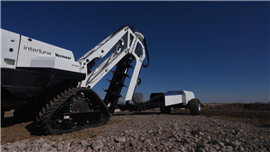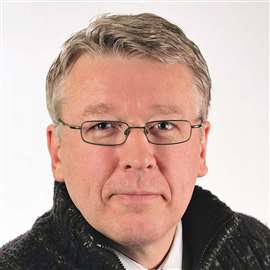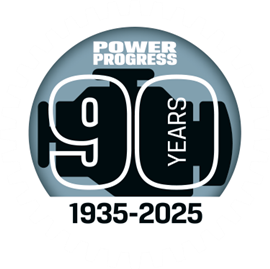Full-scale prototype of Moon excavator introduced
22 May 2025
Interlune, Vermeer to develop excavation equipment, technology for use in space.
 A full-scale prototype of the Interlune excavator, which was developed in partnership with Vermeer. Final Interlune excavator hardware will reportedly be integrated with the Interlune Harvester. (Photo: Interlune)
A full-scale prototype of the Interlune excavator, which was developed in partnership with Vermeer. Final Interlune excavator hardware will reportedly be integrated with the Interlune Harvester. (Photo: Interlune)
Natural resources company Interlune Corp. and equipment manufacturer Vermeer Corp. have unveiled the full-scale prototype of the Interlune excavator, a machine designed to ingest 100 metric tons of Moon dirt, or regolith, per hour and return it to the surface in a continuous motion. Interlune’s immediate focus is harvesting helium-3 from the Moon.
“When you’re operating equipment on the Moon, reliability and performance standards are at a new level,” said Rob Meyerson, Interlune co-founder and CEO, Seattle, Wash. ”Vermeer has a legacy of innovation and excellence that started more than 75 years ago, which makes them the ideal partner for Interlune.”
Helium-3, a stable isotope of helium, is extremely scarce on Earth but abundant on the Moon. Government and industry have been looking for a new and scalable source of helium-3 since the U.S. government identified a severe shortage around 2010.
The excavator is the first product resulting from the joint development agreement; the companies will reportedly continue to explore other novel equipment and technology for use in space and on Earth. Vermeer CEO Jason Andringa will join the Interlune advisory board, as well.
“Vermeer innovation has always been about finding better ways to do important work and this project is no different. Combining my personal passion for aeronautics and astronautics with Vermeer equipment that bears my grandfather’s name to carefully and responsibly harvest resources to make our world a better place is something I’m incredibly proud of,” said Andringa.
Founded by Gary Vermeer in 1948, Iowa-based Vermeer Corp. is now led by his grandson, Andringa. The company makes more than 280 products serving 10 markets to help feed and fuel communities, manage natural resources and connect people to necessities around the world.
“The high-rate excavation needed to harvest helium-3 from the Moon in large quantities has never been attempted before, let alone with high efficiency,” said Gary Lai, Interlune co-founder and CTO. “Vermeer’s response to such an ambitious assignment was to move fast. We’ve been very pleased with the results of the test program to date and look forward to the next phase of development.”
Excavation is the first in a four-step proprietary system to harvest natural resources from space: excavate, sort, extract and separate. The Interlune excavator operates continuously and its design reduces tractive force, power consumption and dust compared to traditional trench-digging techniques. Interlune and Vermeer built the full-size prototype after developing and testing a small-scale version in the summer of 2024.
The excavator prototype and partnership agreement with Vermeer reportedly marks a key milestone in developing the Interlune harvesting system. Interlune is actively testing other technology components, including its sorting and extraction devices in simulated lunar gravity on parabolic flights over the past year. The company develops and tests its proprietary separation technology at its cryogenic lab at the company’s Seattle headquarters.
There is tremendous demand for helium-3 across several industries, including national security, quantum computing, medical imaging, and fusion energy. Interlune aims to be the first company to commercialize natural resources from space, starting with Helium-3 from the Moon, which it will sell to commercial and government customers.
Interlune was founded in 2020 by former Blue Origin President Meyerson and Chief Architect Lai as well as Apollo 17 Astronaut Harrison H. Schmitt. The team also include Indra Hornsby (Rocket Lab, BlackSky) and James Antifaev (Alphabet, Maxar). Aiming to be the first U.S. company to commercialize resources from space, the company said it will offer these resources to customers on Earth and establish an in-space economy.
In 2024, Interlune received individual grants from the U.S. Department of Energy and NASA TechFlights to advance proprietary separation and extraction technologies, respectively. In 2023, the company received a National Science Foundation (NSF) Small Business Innovation Research (SBIR) Phase I award to develop technology to size and sort lunar regolith. Interlune has raised $18 million in funding to date and is planning several missions to the Moon later this decade.
 A rendering of the Interlune Harvester, which will incorporate excavation hardware developed in partnership with Vermeer. (Illustration: Interlune)
A rendering of the Interlune Harvester, which will incorporate excavation hardware developed in partnership with Vermeer. (Illustration: Interlune)
POWER SOURCING GUIDE
The trusted reference and buyer’s guide for 83 years
The original “desktop search engine,” guiding nearly 10,000 users in more than 90 countries it is the primary reference for specifications and details on all the components that go into engine systems.
Visit Now
STAY CONNECTED




Receive the information you need when you need it through our world-leading magazines, newsletters and daily briefings.
CONNECT WITH THE TEAM










